Related Research Articles

Hatshepsut was the Great Royal Wife of Pharaoh Thutmose II and the fifth Pharaoh of the Eighteenth Dynasty of Egypt, ruling first as regent, then as queen regnant from c. 1479 BC until c. 1458 BC. She was Egypt's second confirmed queen regnant, the first being Sobekneferu/Nefrusobek in the Twelfth Dynasty.
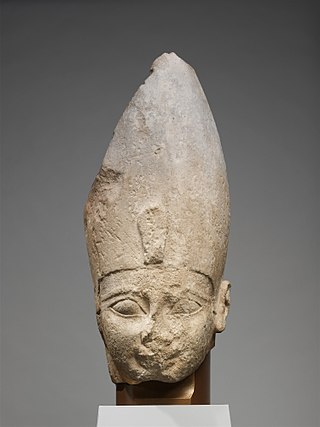
Ahmose I was a pharaoh and founder of the Eighteenth Dynasty of Egypt, classified as the first dynasty of the New Kingdom of Egypt, the era in which ancient Egypt achieved the peak of its power. He was a member of the Theban royal house, the son of pharaoh Seqenenre Tao and brother of the last pharaoh of the Seventeenth Dynasty, Kamose. During the reign of his father or grandfather, Thebes rebelled against the Hyksos, the rulers of Lower Egypt. When he was seven years old, his father was killed, and he was about ten when his brother died of unknown causes after reigning only three years. Ahmose I assumed the throne after the death of his brother, and upon coronation became known as Nebpehtyre, nb-pḥtj-rꜥ "The Lord of Strength is Ra".

Thutmose III, sometimes called Thutmose the Great, was the sixth pharaoh of the 18th Dynasty. Officially he ruled Egypt from 28 April 1479 BC until 11 March 1425 BC, commencing with his coronation at the age of two and concluding with his death, aged fifty-six; however, during the first 22 years of his reign, he was coregent with his stepmother and aunt, Hatshepsut, who was named the pharaoh. While he was shown first on surviving monuments, both were assigned the usual royal names and insignia and neither is given any obvious seniority over the other. Thutmose served as the head of Hatshepsut's armies. During the final two years of his reign, he appointed his son and successor, Amenhotep II, as his junior co-regent. His firstborn son and heir to the throne, Amenemhat, predeceased Thutmose III.
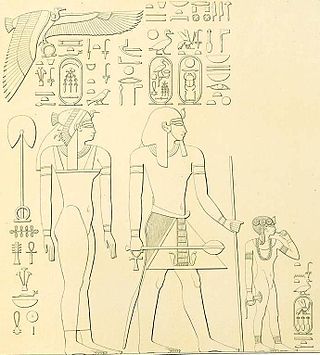
Ahmose was an Ancient Egyptian queen in the Eighteenth Dynasty. She was the Great Royal Wife of the dynasty's third pharaoh, Thutmose I, and the mother of the queen and pharaoh Hatshepsut. Her name means "Born of the Moon".

Thutmose I was the third pharaoh of the 18th Dynasty of Egypt. He received the throne after the death of the previous king, Amenhotep I. During his reign, he campaigned deep into the Levant and Nubia, pushing the borders of Egypt farther than ever before in each region. He also built many temples in Egypt, and a tomb for himself in the Valley of the Kings; he is the first king confirmed to have done this.

Thutmose II was the fourth Pharaoh of the Eighteenth Dynasty of Egypt, and his reign is generally dated from 1493 to 1479 BC. Little is known about him and he is overshadowed by his father Thutmose I, half-sister and wife Hatshepsut, and son Thutmose III. He died around the age of 30 and his body was found in the Deir el-Bahri Cache above the Mortuary Temple of Hatshepsut.
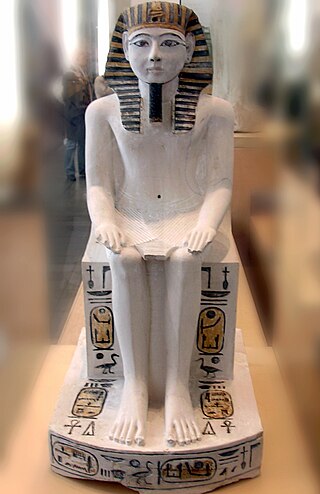
Amenhotep I or Amenophis I, was the second Pharaoh of the 18th Dynasty of Egypt. His reign is generally dated from 1526 to 1506 BC.
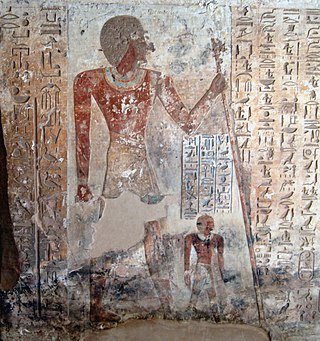
Ahmose, son of Ebana, served in the Egyptian military under the pharaohs Ahmose I, Amenhotep I, and Thutmose I. His autobiography, which is inscribed on the wall of his tomb, and remains remarkably intact, is a valuable source of information on the late 17th Dynasty and the early 18th Dynasty of Egypt.

The New Kingdom, also referred to as the Egyptian Empire, was the ancient Egyptian nation between the 16th century BC and the 11th century BC. This period of ancient Egyptian history covers the Eighteenth, Nineteenth, and Twentieth Dynasties. Through radiocarbon dating, the establishment of the New Kingdom has been placed between 1570 BC and 1544 BC. The New Kingdom followed the Second Intermediate Period and was succeeded by the Third Intermediate Period. It was the most prosperous time for the Egyptian people and marked the peak of Egypt's power.

Ahmose-Nefertari was the first Great Royal Wife of the 18th Dynasty of Ancient Egypt. She was a daughter of Seqenenre Tao and Ahhotep I, and royal sister and wife to Ahmose I. Her son Amenhotep I became pharaoh and she may have served as his regent when he was young. Ahmose-Nefertari was deified after her death.
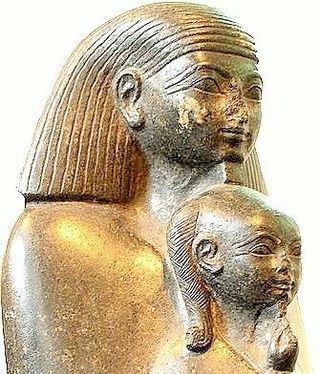
Neferure or Neferura was an Egyptian princess of the Eighteenth Dynasty of Egypt. She was the daughter of two pharaohs, Hatshepsut and Thutmose II. She served in high offices in the government and the religious administration of Ancient Egypt.

Satiah was an ancient Egyptian queen, the first Great Royal Wife of Pharaoh Thutmose III.

Ahmose-Sapair was a prince of the late Seventeenth Dynasty of Egypt.
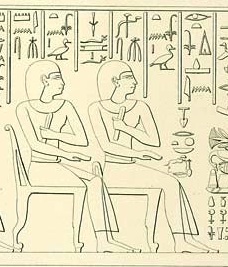
Amenmose was an ancient Egyptian prince. He lived during the 18th dynasty and was the eldest son and designated heir of Thutmose I. He predeceased his father.
Ipu was a royal nurse during the 18th Dynasty of ancient Egypt. She was the mother of Queen Satiah, Great Royal Wife of Pharaoh Thutmose III.

The Eighteenth Dynasty of Egypt is classified as the first dynasty of the New Kingdom of Egypt, the era in which ancient Egypt achieved the peak of its power. The Eighteenth Dynasty spanned the period from 1550/1549 to 1292 BC. This dynasty is also known as the Thutmosid Dynasty for the four pharaohs named Thutmose.
This page list topics related to ancient Egypt.
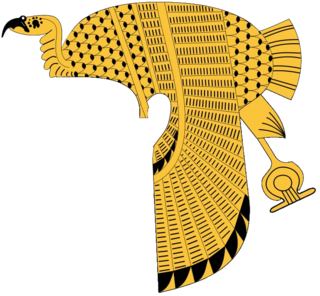
The Vulture crown was an ancient Egyptian crown worn by Great Royal Wives and female pharaohs. It was depicted as a headdress in the shape of a vulture draped over the head, with its wings hanging down on the sides. It was a symbol of protection associated with the vulture goddess Nekhbet, who often wore this crown when depicted in a human form. These crowns were frequently worn by the Great Royal Wife, high ranking priestesses, and female pharaohs. These crowns were also sometimes equipped with the Uraeus to symbolize Wadjet, representing both Upper (Nekhbet) and Lower Egypt (Wadjet).
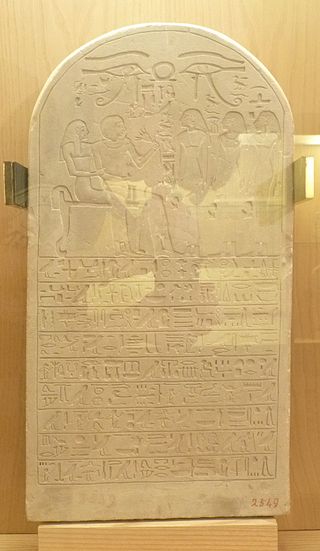
Hormeni was an ancient Egyptian dignitary who officiated at the beginning of the Eighteenth Dynasty.
Senimen was an ancient Egyptian official who lived at the beginning of the 18th Dynasty and who was tutor of the king's daughter Neferure. The latter had an exceptionally high status under the ruling queen Hatshepsut.
References
- ↑ Cooper, Julien Charles (2020-07-22), "Foreigners on the Periphery: The Language and Phonology of Foreign Names", Toponymy on the Periphery, Brill, pp. 71–112, ISBN 978-90-04-42221-6 , retrieved 2024-01-29
- ↑ Shirley, Jj (2011-01-01), "What's In A Title? Military And Civil Officials In The Egyptian 18th Dynasty Military Sphere", Egypt, Canaan and Israel: History, Imperialism, Ideology and Literature, Brill, pp. 291–319, ISBN 978-90-04-21069-1 , retrieved 2024-01-29
- ↑ Roehrig, Catharine H. (1990). The Eighteenth Dynasty Titles Royal Nurse (mnʼt Nswt), Royal Tutor (mnʼnswt), and Foster Brother/Sister of the Lord of the Two Lands (sn/snt Mnʼn Nb T3wy). UMI.
- ↑ Allon, Niv; Navratilova, Hana (2017-05-18). Ancient Egyptian Scribes: A Cultural Exploration. Bloomsbury Publishing. ISBN 978-1-4725-8398-7.
- "Biography of Ahmose Pen-Nekhbet" in Ancient Records of Egypt by J. H. Breasted, Part Two, sections 17ff, 40ff. Full text on Archive
- Anneke Bart: The New Kingdom Tombs of El Kab / Nekhen